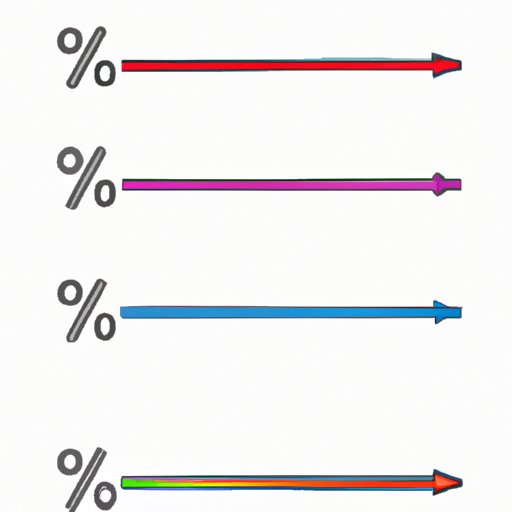
Introduction
Calculating percentage difference is an essential skill in a variety of contexts, from finance and economics to sports and science. This calculation allows us to see how much something has changed or grown in relation to its original or starting value. By mastering this calculation, we can better understand trends, make informed decisions, and track progress. In this article, we will provide a step-by-step guide to calculating percentage difference, present real-life examples, discuss the importance of visual aids, explain the formula in detail, identify common mistakes, and recommend online tools to simplify the process.
Step-by-Step Guide
To calculate percentage difference, follow these steps:
a. Determine the original or starting value
The original or starting value is the value before any changes are made. This value is typically denoted by “A.” For example, if you want to calculate the percentage difference in the price of a stock, the starting value would be the price at the beginning of the period you are examining.
b. Determine the new or final value
The new or final value is the value after the changes have been made. This value is typically denoted by “B.” Using the same example as before, the final value would be the price of the stock at the end of the period.
c. Find the difference between the two values
Calculate the absolute difference between the two values (the absolute value of the subtraction). For example, if the starting value of a stock was $100 and the final value was $150, the difference would be $50.
d. Divide the difference by the original value and multiply by 100 to get the percentage difference
To find the percentage difference, divide the absolute difference by the original value and multiply by 100. The formula can be written as:
Percentage Difference = |(B – A) / A| x 100%
Using our previous example, the percentage difference in the stock price would be:
Percentage Difference = |($150 – $100) / $100| x 100%
Percentage Difference = 50%
Real-Life Examples
Percentage difference can be useful in many real-life scenarios. Here are a few examples:
Example 1: Economics
In economics, percentage difference is used to measure inflation, economic growth, and employment. For instance, if the income of a company increases from $50 million to $60 million over a year, the percentage difference would be a 20% increase.
Example 2: Science
Chemists use percentage difference to measure the precision of their measurement instruments. If a scientist calculates the density of an object using two different instruments and gets 10g/cm³ and 11g/cm³, the percentage difference would be:
Percentage Difference = |(11 – 10) / [(11 + 10) / 2]| x 100%
Percentage Difference = 4.55%
Example 3: Sports
In sports, percentage difference is often used to compare the performance of athletes. For instance, if a runner sets a personal best time of 10 seconds in the 100m dash, and later breaks this record by running it in 9.8 seconds, the percentage difference would be a 2% improvement.
Visual Aids
Visual aids play a vital role in helping people understand percentage difference. Here are some visual aids that can be used:
Infographics
Infographics are an easy-to-understand visual tool that can be used to explain the concept of percentage difference. They can highlight important points, provide numerical data, and help people visualize the differences between values using graphs and charts.
Tables and Charts
Tables and charts are another visual aid that can help people understand percentage difference. They can help people compare different values, highlight differences, and provide a clear overview of numerical data.
Formula Explanation
The formula for calculating percentage difference is:
Percentage Difference = |(B – A) / [(A + B) / 2]| x 100%
This formula takes into account the arithmetic mean of A and B to ensure that the calculation is as accurate as possible.
To address negative values, you can use brackets and absolute values. For example, if A is negative and B is positive:
Percentage Difference = |[(B – A) / |A| + |B|)] / 2| x 100%
Common Mistakes
Some common mistakes when calculating percentage difference include forgetting to use absolute values, dividing the absolute difference by the final value instead of the original value, and misinterpreting the results.
To avoid these mistakes, always double-check your calculations, use absolute values, and interpret the results carefully.
Online Tools
Several online tools can help with calculating percentage difference, including:
Calculator.net
Calculator.net’s percentage change calculator is a straightforward tool that lets users input the starting and ending values and quickly calculate the percentage difference.
Omni Calculator
Omni Calculator’s percentage change calculator is a handy tool that includes examples to illustrate how the calculation works.
Conclusion
Calculating percentage difference is a crucial skill in many contexts. By mastering this calculation, we can better understand changes and trends, make informed decisions, and track our progress. We hope this step-by-step guide, with real-life examples, formula explanation, best practices, visual aids, and online tools, will help you master the calculation and apply it effectively in your life and work. Remember always to double-check your calculations, use absolute values, and interpret the results carefully.




